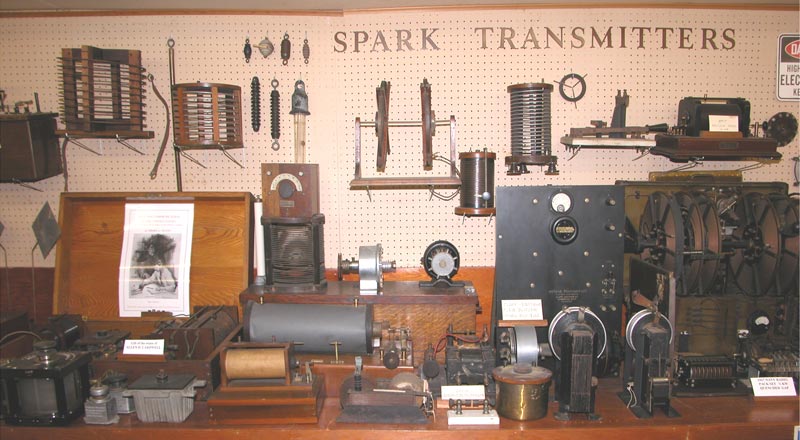Here is a wireless receiver…these are the antennas…this is the coherer right here, and the bell is the tapper. The transmitter is over there…a spark coil connects to it.
This is a very early Marconi Jigger…Marconi used the term “Jigger” to describe an induction coil. It has taps for different amounts of induction. And it’s built…you see these little pins here? You can stack a second and third coil on and make transformer arrangements. That’s very early. Marconi Wireless Telegraph Company, London. Circa 1900.
This is a coherer receiver, gift of Vance Phillips, who was a great collector of detectors. The Phillips collection of detectors is in the other room, in one of the glass cases.
This is kind of cute. It’s a portable wireless set in a box. And apparently…well, here are the earphones…here is the crystal detector, the galena detector…this side is the receiver…that’s the key…this side is the transmitter…induction coil…spark gap…this is the antenna changer switch…so, some proud kid in 1910-ish had a two-way radio…spark, of course.
This is a high-voltage mica condenser. What is interesting is that Cardwell was a famous manufacturer of such things in the old days, and the fact that it came from his estate is significant.
Just more induction coils…induction coils. This is a high-voltage transformer with a protection gap at the top, so the voltage doesn’t go too high and burn the coil out.
This is an induction coil with a vibrator here.
Fred – “Oh, is that a bit like a Model T ignition coil?
Same thing, exactly. Even a modern automobile has a spark coil, you know.
Fred – “Of course, one of the things that inhibited them greatly was having good enough insulation. In most of this old equipment, has the insulation stood up, or is that a common problem with old equipment?”
They didn’t do much better than varnished oak wood. See here? This is a spark gap here, and there’s nothing insulated beyond the wood. This is the on/off switch. And of course, it vibrated…spark coil type thing.
Years and years ago, when amateurs were doing things by spark, they would get a big transformer…high-voltage spark gap, and just put a key in there, make a lot of static, and…it’s surprising…
Fred – “Try not to electrocute themselves…”
Well, they learn a lot.
This…Clapp-Eastham is the company that evolved into General Radio. Was General Radio still there when you were in Cambridge?
Fred – “I don’t know. I think it was, actually.”
They were right behind MIT. Anyway, they made nice equipment in Cambridge, Mass.
Text from the transcript of a tour of New England Wireless & Steam Museum’s Wireless Building given by Robert W. Merriam on a winter day in 2012. Transcription by Craig H. Moody, K1CHM. Edited by Fred Jaggi.
